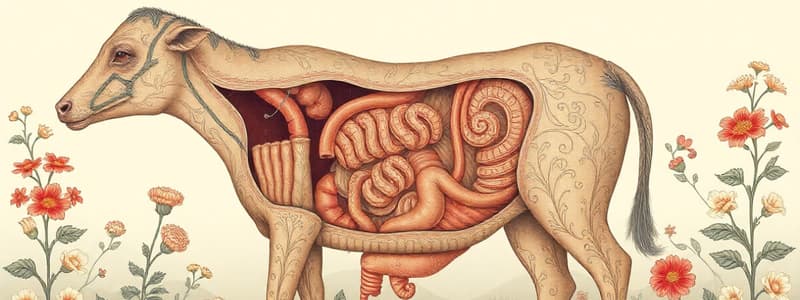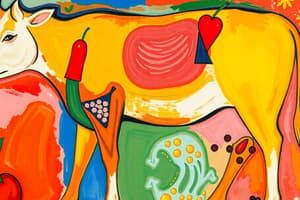Podcast
Questions and Answers
What is the primary function of the digestive system?
What is the primary function of the digestive system?
To change food into chemical forms the body can use.
What happens to anything the body can't use?
What happens to anything the body can't use?
It must be properly eliminated.
What are the two types of digestion?
What are the two types of digestion?
- Mechanical and Physical
- Physical and Chemical
- Chemical and Mechanical (correct)
- Physical and Biological
Where does mechanical digestion occur?
Where does mechanical digestion occur?
What is involved in chemical digestion?
What is involved in chemical digestion?
What is the process called where nutrients and water are taken in through the small and large intestines?
What is the process called where nutrients and water are taken in through the small and large intestines?
What is the process called where waste food material is removed from the body?
What is the process called where waste food material is removed from the body?
What is the digestive tract in most animals called?
What is the digestive tract in most animals called?
What are the six main organs that make up the alimentary canal in humans?
What are the six main organs that make up the alimentary canal in humans?
What are the accessory glands and organs that help with digestion?
What are the accessory glands and organs that help with digestion?
Herbivores and omnivores usually have shorter digestive tracts than carnivores.
Herbivores and omnivores usually have shorter digestive tracts than carnivores.
What is the role of the epiglottis in digestion?
What is the role of the epiglottis in digestion?
What are the muscular contractions in the esophagus called, and what is their purpose?
What are the muscular contractions in the esophagus called, and what is their purpose?
What is the function of the cardiac/esophageal sphincter?
What is the function of the cardiac/esophageal sphincter?
What are the gastric juices in the stomach composed of?
What are the gastric juices in the stomach composed of?
What is chyme?
What is chyme?
What is the role of the pyloric sphincter?
What is the role of the pyloric sphincter?
What are the three main parts of the small intestine?
What are the three main parts of the small intestine?
Why is the duodenum an important site for chemical digestion?
Why is the duodenum an important site for chemical digestion?
What is the main function of the jejunum?
What is the main function of the jejunum?
What do the folds (plica) in the small intestine do?
What do the folds (plica) in the small intestine do?
What are the finger-like projections on the plica called?
What are the finger-like projections on the plica called?
What are the microscopic projections on the villi called?
What are the microscopic projections on the villi called?
What percentage of absorption occurs in the small intestine?
What percentage of absorption occurs in the small intestine?
What is the role of the capillaries in the villi?
What is the role of the capillaries in the villi?
What are the four main sections of the large intestine?
What are the four main sections of the large intestine?
What is the main function of the colon?
What is the main function of the colon?
Flashcards
Primary function of digestive system
Primary function of digestive system
Convert food into usable chemicals for the body and remove unusable substances.
Ingestion
Ingestion
Taking in food.
Mechanical digestion
Mechanical digestion
Physical breakdown of food into smaller pieces.
Chemical digestion
Chemical digestion
Signup and view all the flashcards
Absorption
Absorption
Signup and view all the flashcards
Egestion
Egestion
Signup and view all the flashcards
Alimentary canal
Alimentary canal
Signup and view all the flashcards
Mouth (mammals)
Mouth (mammals)
Signup and view all the flashcards
Incisors
Incisors
Signup and view all the flashcards
Canines/Bicuspids
Canines/Bicuspids
Signup and view all the flashcards
Molars
Molars
Signup and view all the flashcards
Uvula
Uvula
Signup and view all the flashcards
Saliva
Saliva
Signup and view all the flashcards
Bolus
Bolus
Signup and view all the flashcards
Esophagus
Esophagus
Signup and view all the flashcards
Peristalsis
Peristalsis
Signup and view all the flashcards
Stomach
Stomach
Signup and view all the flashcards
Gastric juices
Gastric juices
Signup and view all the flashcards
Chyme
Chyme
Signup and view all the flashcards
Small Intestine
Small Intestine
Signup and view all the flashcards
Duodenum
Duodenum
Signup and view all the flashcards
Study Notes
Digestive System Overview
- The digestive system's primary function is to convert the food we eat into usable chemical forms, and eliminate what the body cannot use.
Steps in Digestion
- Ingestion: Taking in food.
- Digestion: Preparing food for breakdown.
- Mechanical Digestion: Physically breaking down food (e.g., chewing, churning). This increases surface area for chemical digestion.
- Chemical Digestion: Using enzymes to break down food into smaller molecules. This happens via digestive juices from glands.
- Absorption: Absorbing nutrients and water in the small and large intestines.
- Egestion/Elimination: Removing waste food material from the body.
Digestive Tract in Animals
- The digestive tract is a long tube (alimentary canal) in most animals.
- It starts at the mouth and ends at the anus.
- Food is broken down and absorbed as it moves along this tube.
Human Digestive System
- Six main organs make up the human alimentary canal: mouth, pharynx, esophagus, stomach, small intestine, and large intestine.
- Accessory glands and organs (salivary glands, pancreas, liver, and gallbladder) secrete digestive juices into the alimentary canal.
Digestive Tract Length
- Herbivores and omnivores typically have longer digestive tracts than carnivores (relative to their body size). This is because they need to break down plant material, which is more complex.
Mouth
- Contains teeth, used for chewing, grinding food into smaller pieces.
- The uvula prevents food from entering the respiratory system while swallowing.
- Saliva, produced by salivary glands, contains amylase (an enzyme) to aid in the chemical digestion of starches.
- A bolus is a rounded mass of chewed food ready for swallowing.
Esophagus
- Tube that transports food from the mouth to the stomach via muscular contractions called peristalsis.
- The epiglottis closes the trachea to prevent food from entering the lungs.
Stomach
- A muscular, J-shaped sac-like organ.
- Food enters the stomach via the cardiac/esophageal sphincter.
- The stomach contains gastric glands that produce gastric juices containing hydrochloric acid and enzymes (like pepsin) and mucus to protect the stomach lining.
- Muscles mix food with gastric juices, creating chyme (a thick liquid).
- The pyloric sphincter controls the flow of chyme from the stomach to the small intestine.
Small Intestine
- Approximately 6 meters long, and 2.5 cm wide.
- Divided into three sections: duodenum, jejunum, and ileum.
- The duodenum receives pancreatic and bile secretions, making it the primary site for chemical digestion.
- The jejunum and ileum are essential for nutrient absorption.
- The small intestine has folds (plicae) and finger-like projections (villi) with even smaller projections (microvilli) which greatly increase its surface area for nutrient absorption.
- About 80% of absorption takes place in the small intestine.
- The villi contain capillaries that allow for easy nutrient diffusion into the bloodstream.
Large Intestine
- Consists of several sections: cecum, colon, rectum and anus.
- Approximately 1.5 meters long and 5 cm wide.
- The colon absorbs water and minerals, and provides a habitat to bacteria that produce vitamin K, a crucial vitamin.
- The cecum receives chyme from the small intestine.
- The appendix is attached to the cecum but its function is debatable but is thought to have an immune function.
- The rectum is the last part of the digestive tract, storing and transporting waste.
- The anus is the exit point for waste, controlled by two sphincters.
Fecal Composition
- Feces are about 75% water and 25% solid matter.
Accessory Organs in Digestion
- Salivary Glands: Secrete saliva containing amylase to aid in starch digestion.
- Liver: Filters blood, cleanses of toxins, produces bile, stores glycogen, and aids in food digestion.
- Gall Bladder: Stores and concentrates bile, essential for lipid digestion, and releases bile into the duodenum when fats are detected.
- Pancreas: Produces enzymes to digest carbohydrates, proteins, and fats, and plays a critical role in regulating blood sugar levels through insulin and glucagon.
Digestion Timeline
- Provides an overview of how long food spends in different parts of the digestive system.
Enzymes in Chemical Digestion
- Details the enzymes involved in breaking down carbohydrates, proteins, and lipids into simpler components that can be absorbed by the body.
Studying That Suits You
Use AI to generate personalized quizzes and flashcards to suit your learning preferences.




